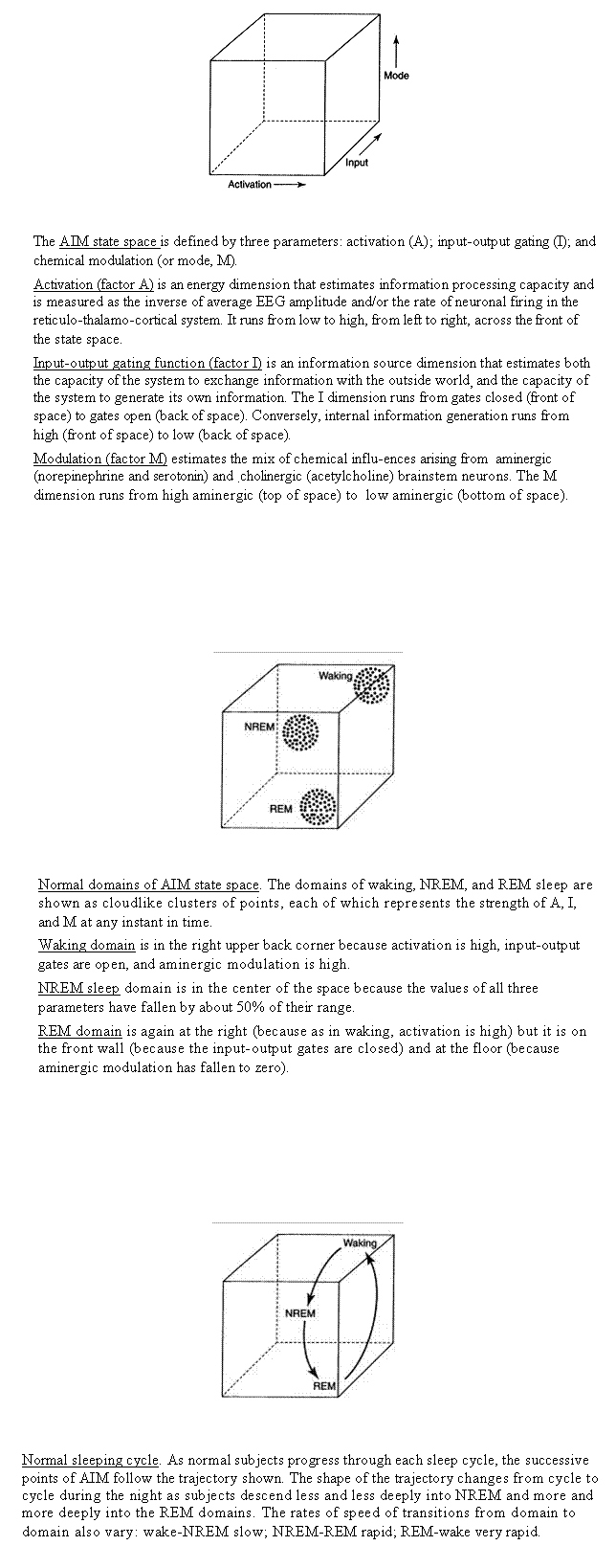|
Allan Hobson’s AIM Model for Consciousness Hobson, Dream Drugstore, p.45ff |

|
Alan Hobson has conceived a three-dimensional state space of brain-related variables as a way of visualizing the consciousness states. With AIM model axes for (1) Activation, (2) Input-output gating, and (3) Modulation, it is possible to track the brain-mind waking, sleeping and abnormal states as a continuous succession of points. The cardinal states of waking, NREM sleep, and REM sleep occupy distinct regions of the state space, in which waking and REM are clearly differentiated. ActivationActivation denotes rate of information processing. The cortex is "activated" if the EEG shows a low-voltge, fast brain-wave pattern. Activation can be measured as the power of the high-frequency component and/or as the inverse of the low-frequency power in the EEG spectrum. Activation can also be measured by imaging brain regions (with blood flow as the measure), and behaviorally (with reaction time as the measure). Information sourceInformation source varies from external to internal depending upon (1) input-output gating and (2) internal stimulus generation. In order for the brain-mind to process external data the sensory input and motor output gates must be open (waking) and internal stimuli must be suppressed. In dreaming, just the opposite is the case input-output gates are closed and internal stimulus generation is enhanced. Strength of I can be measured by quantifying postural muscle tone (EMG) and eye-movement activity (EOG). ModulationModulation estimates the mix of chemical influences arising from aminergic (norepinephrine and serotonin) and cholinergic (acetylcholine) brainstem neurons. Modulation determines the way that information is processed, whatever its source. The easiest way to understand M is to realize that it also stands for memory. The strength of M determines whether the brain-mind keeps a record of its conscious experience (waking) or does not (dreaming). M probably also determines the mode of associative processing, so that associations are either tight and logical (waking) or loose and emotionally organized (dreaming).
|
|
(paraphrase of Allan Hobson; Pace-Schott; Sleep and Dreaming, p.49) Summary of the AIM model and the nature of conscious states The AIM model describes a method of mapping conscious states onto an underlying physiological state space. The AIM model relates not just to wake-sleep states of consciousness, but to all states of consciousness. It is limited by describing only three, of what are undoubtedly numerous dimensions that must be specified to completely define this state space, but we have chosen those parameters that we feel are most critical for distinguishing among the basic wake-sleep states of consciousness. By choosing activation, input source, and mode of neuromodulation as our three dimensions, we have selected how much information is being processed by the brain (A), what information is being processed (I), and how it is being processed (M). It is our belief that these three parameters are both necessary and sufficient to distinguish in a preliminary way among the basic wake-sleep states. While the brain normally exists in specific regions of the AIM state space, only shifting from one area to another at relatively infrequent intervals, the brain is nonetheless theoretically capable of occupying any position in this state space, displaying any set of values of A, I, and M. As such, intermediate states and dissociated states are recognized as not only eminently possible but highly probable, and specific states of consciousness are seen more as convenient names for frequently occupied regions of the state space than as discrete, tightly bounded areas of the state space. In addition, transition from one stable brain/mind state to another involves moving along a continuous path through the state space, linking the two stable states. Finally, although we believe that these three dimensions go a long way towards mapping what we know about the physiological processes underlying conscious states today, we believe that many more exist and as a result, our mapping from physiological state space to conscious states is an approximation that further experimentation can only serve to further refine. (end of paraphrase) |